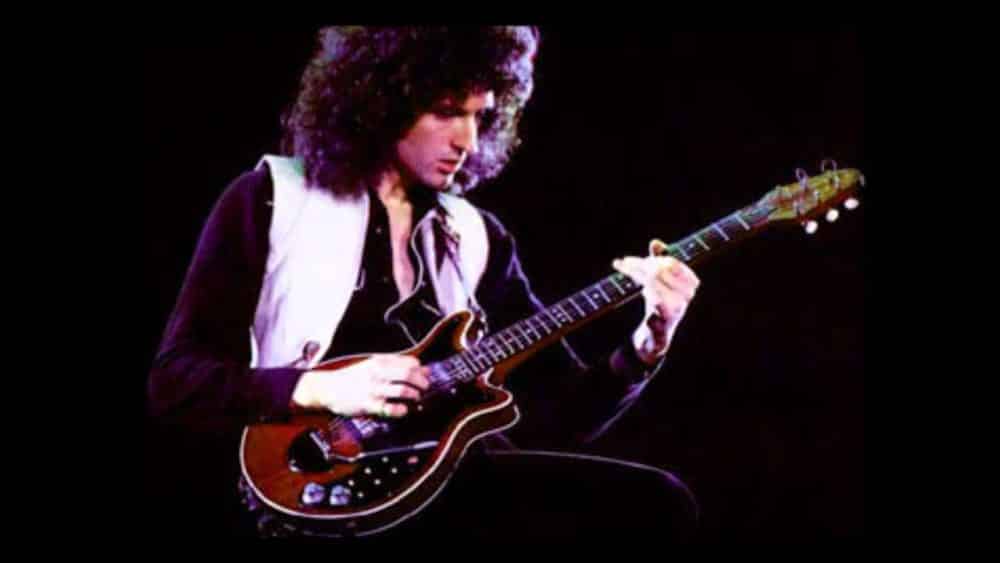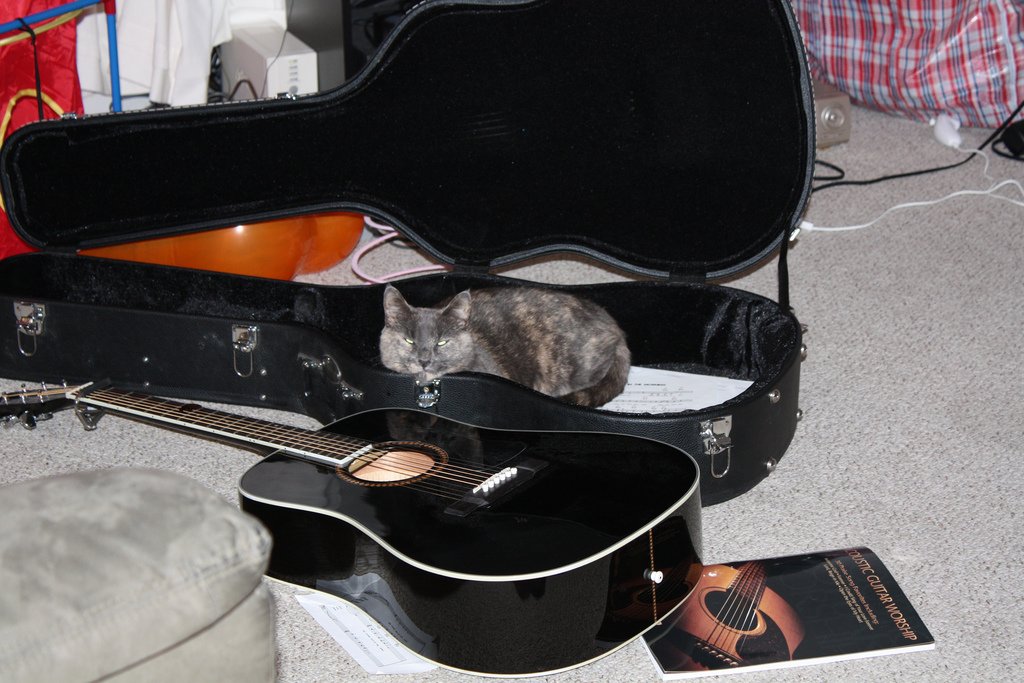A detailed analysis of my top 5 Queen Guitar solos by Brian May, in no particular order, and most of them sadly forgotten.
The Hero
Flash Gordon – 1980
The Hero is unique for a Queen song in that it serves as a sort of epilogue at the end of the Flash Gordon album, revisiting many songs, starting with Battle Theme, before moving onto others. What I really love about the solo is, firstly, it revisits one of my favourite musical passages, the slow and best part of Flash’s Theme, you know the one: Just a man, with a man’s courage, but not only that, the solo is a sort of greatest hits, a parody almost, of Brian Mays solo technique. The screaming out-out phase tone. The unmistakable sixpence pick rake followed by the huge high bend and vibrato.
It begins after an aural assault of keyboards, strings, and lightning no less, (2:11) with stripped-down, crunchy chords. You just know something special’s coming. Phrasing wise, it reminds me of Spread Your Wings a lot in the way he uses a repeating phrase against the moving chords (2:20). It’s just so in your face, unashamedly over the top and tongue in cheek, and fits in perfectly with the feel of the film. At 2:27 (predictably) we have the trademark guitar harmonies, following by just about the most emotive string bend you’ll ever hear.
Technically, as we’ll cover more in Don’t Stop Me Now, it’s no great stretch, but Brian has mastered the art of playing across the chords rather the playing the boxes, and that’s the stuff you can’t teach and the reason Brian May’s solos are so memorable. What Brian commonly does is, in effect, sing the melody on guitar, whilst adding subtle variations. It’s less about playing a scale or following the rules, and more about revisiting and enhancing the hook of the song, in his own words so to speak.
Love of My Life
A Night at the Opera – 1975
The grandiose of the recorded version has mostly been overlooked since this track became an acoustic live stadium crowd-pleaser, but I urge you to listen again to this masterpiece of guitar orchestration. The stand-out aspect here is the variation of tone from full and fat, to wiry and brash, in and out of phase. This is the Red Special put to its ultimate use and doing what it was designed to do.
The solo itself meshes seamlessly with the intricate piano work (2:18), starting off with phrases that, again, provide subtle variations of the vocal. The tone at this point is in-phase, syrupy thick, but choked-sounding, which only adds to the tensions and the interest. So far so good, then two surprises, first, an epic slide of raw emotion (2:30) ending on a gloriously unexpected (and rare for Brian) pinch harmonic (2:32) which blooms blissfully into singing feedback. We then have a repeating variation on this, with the tone opening out but this time the harmonic omitted to emphasize more singing harmonic feedback from the famous semi-acoustic chambers of perhaps the world’s most famous guitar. The most satisfying of musical resolutions.
To end, the focus turns to guitar layering and orchestration (2:47), using many contrasting tones that meld beautifully in a guitar choir, with the final, lonely flourish (2:58) being almost heart-breakingly understated, with an even more choked-out, and this time out-of-phase tone that sounds like the guitar itself has a lump in its throat.
We Will Rock You
News Of The World – 1977
The genius of this is, well, it’s not really a guitar solo is it?. Secondly, it uses perhaps Brian May’s most (over)used riff, the All Right Now inspired A into D/A used in It’s Late From the same album, and then later most famously in Hammer to Fall and A Kind Of Magic among many others. Thirdly, despite all that, it’s become one of the world’s best-known solos. It just works.
What I love about Brian May’s guitar tone is that it subtly changes on every album. For example on A Kind of Magic, often the guitar tone is set up to resemble bagpipes (of all things) to cleverly fit in with the theme of the movie Highlander. On The News Of The World, things are curiously phasey with more modulation and width than usual. This is perfectly demonstrated as the feedback fades in at 2:16 followed by a crashing C chord introducing a massive guitar assault which may even have a tinge of fuzz. Eric Clapton once said that single note lines don’t really work with blues, and that theory holds true here too, I just can’t imagine anything but distorted chords working with the sparse claps and foot-stomps.
But what’s really clever about this solo is the rhythmic variation Brian adds to the mix (1:41) which breaks up what would otherwise be something a lot more predictable. It’s also deceptively complex in the way embellishments are added at 1:48. Easy on the ear but not on the fingers, and adding a perfectly judged amount of showy fireworks to elevate it further.
Save Me
The Game – 1980
So why did I pick this over other Greatest Hits standards such as Bohemian Rhapsody, Play The Game, Good Old Fashioned Lover Boy, We Are The Champions, etc, etc? Well, the story is, back in the day, Queen’s Greatest Hits was the background music to our childhood, our first taste of alcohol and girls, and do you know what? The Save Me solo was, above all others, the one that made everyone look up at each other knowingly in acknowledgment and appreciation. For want of another word, it screams!
But it’s not all about the shock factor, it begins at 2:32 with, well, nothing really, just a gorgeously subdued acoustic backdrop to some expertly crafted guitar soundscapes (Queen still proudly boasted ‘no synths’ at this point) ending with a tasty acoustic run into a regal-sounding harmonised pattern at 2:44 before giving way to the vocals again. Yep, the Save Me guitar solo manages to throw out the structure rulebook without anyone noticing. As we all sat around the hi-fi, we were content with Freddie’s dulcet tones singing us out, only to be smashed in the face at 3:07 with an out-of-phase treble boosted Red-Special. As we perked up like meerkats, this glides into a masterful ascending and descending arpeggio chord shape before the money shot at 3:15, prompting those knowing glances and probably forming the genesis of my interest in guitar playing soon after.
Don’t Stop Me Now
Jazz – 1978
Two words. Tone and feel.
Here’s another story. As a beginner, I acquired the tab book Queen’s Greatest Hits, off the record. All I wanted to do was play Queen, and mastering this book was the target. You’ve got to start somewhere, of course, so looking through the tab, this one looked to be the easiest, to begin with.
How wrong can you be…
The thing with Don’t Stop Me Now is, you could play the solo note-perfect, and it would still sound NOTHING like it. Why? It’s not about the notes, it’s about the tone and the way the notes are played.
To start, a guitar tone that requires a number of specific elements. The sixpence, the treble-boaster, the ‘Deacy’ amp (or was it the AC30), and, of course, the one and only Red Special. It’s rich and warm, but with that metallic bite that cuts through anything. It’s what all us guitarists want but never get: Articulation, sustain, and a rich, woody foundation, with a little unruly sizzle on top. Worth noting that it sounds like the bridge/middle in phase on this one.
Then there’s Brian May’s calling card, the technique that identifies any solo as being his: the pick rake (2:18 and onwards) into the bend, introducing each phrase with a dramatic crunch of the sixpence. I’ve tried it. I can’t do it. I’m not worthy.
So I’m not even going to analyse the solo itself. All that needs to be said is this is the best guitar tone I’ve ever heard. I can play the solo but can’t get near that tone, and never will.
I’ll say it again.
This is the best guitar tone I’ve ever heard.
What’s your favourite Queen Guitar Solo and why? Drop me a comment below.




Great king rat off of first album my favorite lead
Yeah the guitar on Millionaire’s waltz is incredible
Killer Queen is my favourite. The Red Special’s “singing” of the melody is what made me aware of Queen’s music in the first place. It’s still one of Brian May’s most recognisable guitar solos – almost fifty years later…
1-The Millionaire Waltz
2-Save Me
3-Spread Your Wings
4-Made In Heaven
5-Don’t Stop Me Now
Somehow Brian’s favorite solo isn’t included and he didn’t play the Red Special in ‘Crazy Little Thing’. All easily researched.
Hi. This is My top 5 Queen Guitars. Sorry for the confusion.
Crazy Little thing called Love is definitely not in my top 5 but I know that was played on a Telecaster as suggested by Mac, the album’s producer.
Thanks for reading!
GREAT POST!
THANK YOU FOR SHARING….